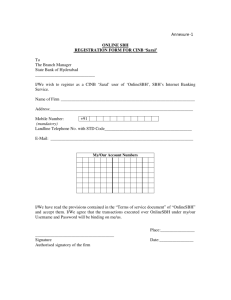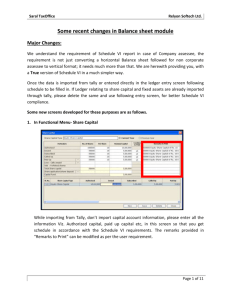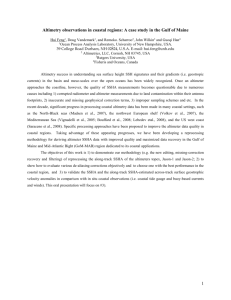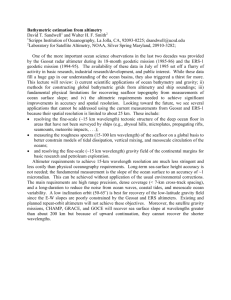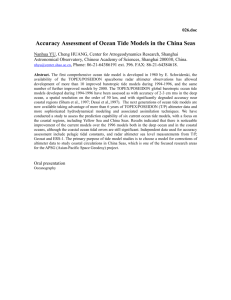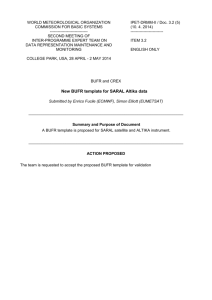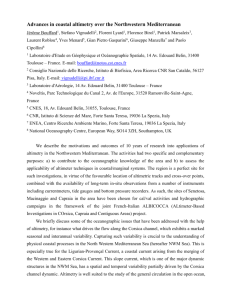SARAL-MG-V1
advertisement
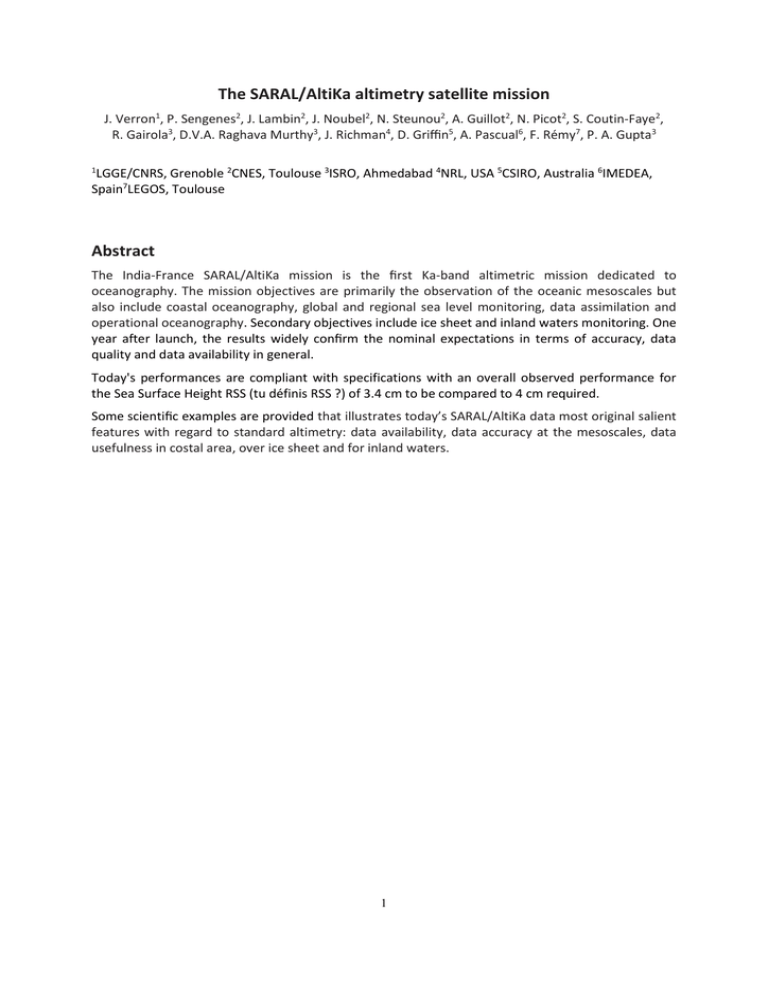
The SARAL/AltiKa altimetry satellite mission J. Verron1, P. Sengenes2, J. Lambin2, J. Noubel2, N. Steunou2, A. Guillot2, N. Picot2, S. Coutin-Faye2, R. Gairola3, D.V.A. Raghava Murthy3, J. Richman4, D. Griffin5, A. Pascual6, F. Rémy7, P. A. Gupta3 1 LGGE/CNRS, Grenoble 2CNES, Toulouse 3ISRO, Ahmedabad 4NRL, USA 5CSIRO, Australia 6IMEDEA, Spain7LEGOS, Toulouse Abstract The India-France SARAL/AltiKa mission is the first Ka-band altimetric mission dedicated to oceanography. The mission objectives are primarily the observation of the oceanic mesoscales but also include coastal oceanography, global and regional sea level monitoring, data assimilation and operational oceanography. Secondary objectives include ice sheet and inland waters monitoring. One year after launch, the results widely confirm the nominal expectations in terms of accuracy, data quality and data availability in general. Today's performances are compliant with specifications with an overall observed performance for the Sea Surface Height RSS (tu définis RSS ?) of 3.4 cm to be compared to 4 cm required. Some scientific examples are provided that illustrates today’s SARAL/AltiKa data most original salient features with regard to standard altimetry: data availability, data accuracy at the mesoscales, data usefulness in costal area, over ice sheet and for inland waters. 1 1. TheSARAL/AltiKaprogram The SARAL (Satellite for ARgos and ALtika) program is a joint mission conducted by the Indian Space Agency (ISRO) and the French Space Agency (CNES) dedicated primarily to ocean observations. The SARAL and ARGOS-3/SARAL Memorandum of Understanding has been signed on February 2007. As its nameindicates, two missions are onboard theSARAL satellite (Figure 1), whichisbased on theISRO "SmallSatelliteBus" platform: AltiKa : a nadir altimeter in Ka-band ARGOS-3: the new generation of ARGOS instrument (ARGOS is a worldwide location and data collection system, see e.g. refARGOS). But exploratory technical developments have been conducted since 1998 and phase B on the instrument was conducted by CNES as early as 2003. Note that by the end of 2009, a formal agreement has been reached with EUMETSAT to take part in the SARAL/AltiKa mission. SARALhasbeenlaunched onFebruary 25,2013 at12:31 UTC. It reached its final orbit on March 13. The AltiKa altimeterhasbeenswitched onfromFebruary26,01:42UTC. Cycle #1 began on 14th March on 05:39:28 UTC. In order to continue the time series and benefit from the existing mean profile, SARAL flies on the same orbit asENVISAT.The orbitis so almostpolar(the final inclination reached is 98.527°), sunsynchronous and with a35-day cycle(seeTable1for all the orbit elements) The SARAL lifetime required is 5 years, but the mission will continue as long asthesatellite and theground segment will operate. Actually, the lifetime requirement concerning AltiKa is 3years of operations, with an objective of5years. Note that regarding ARGOS-3 the lifetime requirement is 5 years with an objective of 7 years expectingly. (ce bloc est bizarre, the lifetime requirement c'est 3 ans ou 5 ans ?) The main responsabilities of the two main partners are as follows (see also Figure 2). The SARAL Satellite is composed of a spacecraft bus IMS-2 (Small Satellite Bus). This platform, developed by ISRO, is designed for satellites in the range of about 500 kg at launch. The payloaddeveloped by CNES is composed of the AltiKaaltimeter-radiometer, a Doris system for precise orbit determination, a Laser Retro-reflector Array instrument used for precise calibration of other POD instruments. EUMETSAT insures the distribution of SARAL/AltiKa payload and auxiliary data to CNES and to ISRO, the NRT processing of SARAL/AltiKa OGDR dataand theNRT dissemination of the SARAL/AltiKa products via EUMETCast and GTS to users outside of India. (pour un article introductif, tu pourrais peut etre déveloper les acronymes notamment POD, NRT, GTS voire OGDR ?) 2. ScientificObjectives TheSARAL/AltiKa missionis an answer to the needs expressedby theoceanographic community(IGOS,GODAE, OSTST) since 2000 : "Continuity of high accuracy, high resolution near real time observations of the ocean surface topography is required. At least, 2 simultaneous altimetry missions are required(including one oftheJason reference class)." As a consequence, the SARAL/AltiKa mission is considered asa "gap filler"betweenENVISAT(lostinApril 2012) andSentinel3(expected mid-2015 (d'apres le site EUmetsat et ESA). SARAL/AltiKa main scientific objective is to provide data products to oceanographic research user community in studies leading to improve our knowledge of the ocean mesoscale variability, thanks to the improvement in spatial and vertical resolution brought by SARAL/AltiKa. Ocean mesoscale variability isdefined as a class ofhigh energyprocesses, with wave lengths within a 50 km to 500 km range, and with periods of a few days to a few months. Kinetic energy of mesoscale variability is one order of magnitude more than mean circulation’s one. Description of mesoscale is thus essential for 2 understanding ocean dynamics, including mean circulation and its climatic effects (through interactions of mesoscale turbulence with the mean flow). This main scientific objective is divided in sub-themes including intrinsic scientific studies of ocean at mesoscale dynamics: observations, theoretical analyses, modelling, data assimilation, etc. This will lead in particular to improve our understanding of the climate system through its key ocean component and especially the role and the impact of mesoscales on the climate variability at large spatial and temporal scales. It will also bring a contributiontothestudy of coastaldynamics which is liable of many downstream applications and also a contribution to operational oceanography which is seeking large amounts of in situ and space observation data. SARAL/AltiKa secondary objectives include the monitoring of the main continental water levels (lakes, rivers, closed seas), the monitoring of mean sea level variations, the observation of polar oceans (thanks to the high inclination of its orbit), the analysis and forecast of wave and wind fields, the study of continental ices (thanks to the lower penetration in Ka-band) and sea ices, the access to low rains climatology (enabled in counterpart to the sensitivity of Ka-band to clouds and low rains) and the marine biogeochemistry(notably throughthe role of the meso and sub-mesoscale physics). 77 Pis(34 proposals from Indian institutions, 16 proposals from 7 French institutions, 27 proposals from non-Indian and non-French institutions) have been selected by CNES andISRO toformtheSARAL/AltiKa scienceteam[1] (Table 2, sympa, mais est-ce vraiment utile ?). All the proposals provide a good coverage of the topics mentioned above. Among them, 49 proposals contribute to the calibration and validationplan[2], concerning on-site verification, global and regional in-situ verification, global statistical and cross-calibration analysis, specific studies(rain effect, sea ice), wet tropospheric correction, sea surface bias, wind and waves. Those studies will permit to assess the SARAL/AltiKa capability to respond to the scientific objectives. 3. AltiKa system description and specifications The AltiKa altimeter inherits from existing nadir altimeter (Poseidon-3 on Jason-2) but operates in a single frequency band : the Ka-band. Indeed, the reduced ionosphere effects in Ka-band authorize a mono-frequency altimeter. Thehigherfrequency(35.75 GHz w.r.t. 13.5 GHz on Jason-2) leads to a smaller footprint (8 km diameter w.r.t. 30 km on Jason-2 and 22 km for Envisat (tu en auras besoin ensuite)) and so a better spatial resolution. ThehigherPulseRepetitionFrequency(4 kHz w.r.t. 2 kHz onJason-2)permits also a better along track sampling of thesurface. Moreover,the enhancedbandwidth(480 MHz w.r.t 320 MHz on Jason-2) induces a better vertical resolution. The altimeter shares the antenna with a K-Ka bifrequency radiometer, respectively with 23.8 GHz and 37 GHz frequencies. The radiometer is required to correct the contribution of wettropospherepathdelay to overall altimeter range measurements. The retrieval algorithm consists in a neural network which inputs are the 2 Brightness Temperatures (BT) measured by the radiometer and the altimeter sigma naught. The novelty in AltiKa is that the altimeter and the radiometer operate at the same frequency. One aspect to underline is that the radiometer in Ka band and the altimeter have the same footprint and the same antenna; that is to say the measures of the 2 instruments are exactly collocated. The radiometer has an on-board calibration. The "hot calibration" consists in the measure of the thermal emission of an internal load. The "cold calibration" is performed using a sky horn to get the cold reference point. The present frequency of calibration is one calibration cycle for 2 antenna cycles. Environmental and geophysical corrections of course contribute also to the Sea Surface Height (SSH) error budget. The ionospheric effectisdramatically reducedinKa-bandwith respect to the Ku-band. Indeed, the attenuation due to the ionosphere is proportional to the inverse of the frequency squared, so the attenuation in Ka-band is about 7 times lower than in Ku-band. In the AltiKa products (like in Jason-2 products), the ionospheric correction willbeinferredfrom aTotalElectronContentmodel, e. g. the GIM model. 3 The wet tropospheric correction, corresponding to the range delay due to atmospheric water vapour, is estimated thanks to the BTs measured by the radiometer, and the ECMWF model(likeJason-2). TheSeaStateBias(SSB) consistsin an empirical correction derived from altimeter data analysis, to adjust the sea surfaceheight "seen"by thealtimeter. Indeed,wavetroughs reflect radar signals better than crests do. Since altimeters measure the height of reflecting surfaces, the measurements are slightly biased toward troughs. At least one year of AltiKa data will be needed to tune the correction. Meanwhile, the formula SSB = 3.5% of Significant Wave Height (SWH) will be used. 4. Mission operations The SARAL/AltiKa satellite has been put into orbit by a PSLV (??) vehicle supplied by ISRO, and launched from Sriharikota, the main ISRO launch base, on February 25, 2013 at 12:31:00 TU. All payload instruments were put in operation within 12 hours from launch. TheAltiKa verificationphasehasbegunwith thecycle1, that is to say since the well-functioning satellite reached its final orbit and crossed the equator at thepredefinelongitude of the first ascending node. After a quick validation performed by the mission project, the NearRealTimeproducts(OGDR andIGDR)havebeendeliveredin "T" version(fortest) totheSARAL/AltiKaPIs from respectively 21st and28thMarch, 2013. Takinginto account thegoodquality of thedata assessedby theproject and the PIs, it has been decided to deliver the O/IGDR data to all users starting in June 2013, although the first verification workshop will take place from 27th to 29th August. Regarding theOfflineproducts(GDR),the firstcycle in "T" version has been delivered to the SARAL/AltiKa PIs on 6th August. A dedicated verification workshop has been ? organized in 2014 (quand ?) to officially validate these products. It has also to be noticed that the SARAL data are included in the Near Real Time Ssalto/Duacs process since the 2nd July 2013. These multi-mission products integrating the SARAL/AltiKa mission are delivered to all users. The planning after launch can be summarized as shown in Figure 2. (pas top ta figure. Tu peux ajouter (ou faire ajouter) un axe des x avec le temps ?) 5. In flight calibration assessment The validation and analysis of the user products quality is a key contributor to the success of any altimetric mission. Conventional validation tools are widely used since the launch of Topex/Poseidon. This includes editing procedures (described in the SARAL/AltiKa User Handbook), a large number of statistical monitoring and visualization tools, mono mission crossovers analysis, sea level anomalies analysis as well as multi mission analysis. They provide essential metrics regarding mission performance to the scientific and operational users. A precise calibration between mission, as well as the careful monitoring of the mission performance over time are ? also crucial to ensure the continuity of the historical satellite altimeter record and allow for climatic studies. This analysis is done on the long term basis but a specific activity is insured during the first months of the mission. The first point to look at is the data coverage, in particular over the ocean. To do so, missing measurements are monitored toward the reference ground track (i.e. assuming a full coverage of the satellite data whatever the conditions are). The comparison to another mission is also essential. This is usually done toward the Jason-2 reference mission. The SARAL/AltiKa data return is remarkably high with a very few missing data over ocean.Over all surfaces, SARAL/AltiKahas less missing measurements than Jason-2 (not shown here – see Prandi et al. this issue, meme sur le Groenland ?) and very slightly less data over the ocean. Over the ocean, the data coverage is greater than 99.5 %, which largely meets the mission requirements (Vincent et al., 2006).Before launch, concerns were raised about the sensitivity of the Ka band to rain events, leading to missing and invalid measurements. Several studies were performed in order to analyse the potential impacts of the rain 4 on the data return. The result of those studies (based on conservative hypothesis and system margin) was that about 5% of data could be lost due to rain events.This is indeed not observed and this is explained by the excellent behaviour of the SARAL altimeter which provides a much better signal to noise ratio that what was anticipated. The second point is the result of the editing procedure. Data selection is required in order to screen the data for spurious records. Obviously this screening depends on the user application and users are advice to tune the editing criteria provided in SARAL/AltiKaProduct Handbook. Over the open ocean about 2.5 % of SARAL data are edited which is less than what we get on the Jason-2 mission (3.5 %). This might be explained by the editing thresholds currently used on SARAL/AltiKa mission that could be too high. But this is also explained by the altitude of the satellite and the frequency used by the altimeter. Indeed the SARAL/AltiKa Ka band altimeter has a much lower footprint size than the one from Jason-2 Ku band altimeter. The radius of the footprint is twice smaller, thus much fewer rain cells, sigma0 bloom events and other heterogeneities of the surface are impacting the Ka band waveform. This is clearly illustrated by the map in Figure 3 which displays the number of edited measurements on SARAL/AltiKa mission compared to Jason-2 (left) and to ENVISAT (right). One can observed that there is fewer data edited on SARAL/AltiKa mission than on Jason-2 mission in the area of rain cells (e.g. around Indonesia) and in the area of sigma0 blooms (e.g. in the Mediterranean sea). Compared to ENVISAT (same altitude, Ku band) 3 years before, we can notice that there is slightly more data edited on SARAL/AltiKa mission. This is explained by the Ka band frequency which is more sensitive to the rain cells than the Ku one’s. J'ai l'impression que c'est pas logique. Dans les zones de pluie, Altika a moins de données que Jason mais plus qu'Envisat. Si je comprends bien, Altika est plus sensible à la pluie mais c'est très compensé avec Jason parce que le rapport des footprint est important (8 versus 30) mais moins par Envisat (8 versus 22) ? Si c'est ca, je suggererai d'inverser le discours. Tu commentes la figure 3 puis tu donnes l'explication. Then the classical crossovers and sea level anomalies are analyzed in details. Sea Surface Height differences at crossovers is the main metric to assess the overall performance of satellite altimetry missions. When applied on a single mission, they provide information about the SSH consistency between ascending and descending tracks. When crossovers are estimated from two different missions, they provide a relative SSH bias estimation and allow to detect potential regional biases and/or drifts between missions. Crossover SSH differences are computed selecting time differences shorter than 10 days (in order to minimize the impact of the ocean variability), and performing a geographical selection to remove high latitudes, shallow waters (depth lower than 1000m) and high oceanic variability areas. The figures obtained on the SARAL/AltiKa mission are of the same order than the one obtained on Jason-2 mission which is remarkable only one year after launch for this new technology mission. Also future evolutions, mainly on the wet tropospheric correction and sea state bias, will further improved the SARAL data quality in the next product version (currently planned early 2015). The same result is obtained on the Sea Level Anomalies: SARAL/AltiKa data quality is as good (or even slightly better) than the Jason-2 one’s. Looking at the SARAL/AltiKa and Jason-2 maps (Figure 4), we can observe the same oceanic signals. The mean bias between SARAL/AltiKa and Jason-2 mission is -5.2 cm and remains to be explained. Another important metric is the spectrum analysis. Compared to Jason-2 and CryoSat-2 (SAR mode) data, the SARAL/AltiKa spectrum content (Figure 5) is fully inline for all wavelengths below 70 kms. We can also notice a much lower white noise, which is due to the excellent Ka band retracking performances and also to the 40 Hz rate (compared to 20 Hz on Jason-2 and CryoSat-2 missions). We can also observe a different signature of the spectral hump. This signature is explained in the paper by Dibarboure et al. in this issue and is linked to the altimeter response to events such as sigma0 blooms or rain cells which tends to modify the altimeter waveforms and so the retracking estimates outputted by the current algorithms (based on Brown model). This is not the case on Cryosat-2 SAR data due to thin stripe-shaped footprint. (ca contredit légèrement ce qu'il y a avant mais bon…) Finally, the table.3 provides metrics regarding the system budget, the actual figures computed with flight data are fully inline with the mission requirements. 5 Clearly, there is still to be done, e.g. through ongoing actions led within the CNES PEACHI project that aims at further improving processing algorithms, including computation of SSB table, ice retracking algorithm. In particular some algorithms (neural network usedfor radiometer dataground processing, Sea State Bias computation, altimeter wind speed and ICE2 retracking, ...) need still to be tuned and should further improve the data. Ca change de ton ! J'aurai mis ca dans la conclusion. 6. Some scientific results (JV) It is not in the scope of this paper to develop about the scientific applications that have already been made or will be made with theSARAL/AltiKadata. Papersinthe same issue of the journal will address many of these aspects in various scientific domains. It is however very comforting to notice even at this stage that the scientific objectives of the mission are very well covered. Here we decided to illustrate how some strong features that appear atthis stagefromtheSARAL/AltiKadata and that characterize SARAL/AltiKa with a specific identity prove to directly impact the scientific and/or operational use of SARAL/AltiKa data: 6.1. Ease of use: Impact of AltiKa data on operational models Altimetry is one of the most important data sources for assimilation into operational models. Operational models require the data in near-real time, when the environmental corrections and precision orbit are not available in their most accurate form on the geophysical data records. SARAL/AltiKa represent the beginning of a new class of altimeters operating at Ka band frequency with a small footprint and high pulse rate. Prior to assimilation, the altimeter data passes through quality control (QC) developed at the Naval Research Laboratory (oui mais ailleurs pour la France). Early results from the QC showed SARAL/AltiKa to perform at or better than previous Ku band altimeters, which lower sensor noise and fewer data dropouts. To check the impact of AltiKa on the operational models, a six month series of data denial experiments were performed using the operation Gulf of Mexico forecast model in a nowcast mode. Compared to the operational model, the SARAL/AltiKa only nowcast has ½ the rms error in steric SSH and mixed layer depth of the Jason-2 only nowcast (Figure 6). From these experiments, it is not possible to determine if the performance gain with SARAL/AltiKa comes from the better performance of the altimeter or from the different track spacing of SARAL/AltiKa. To test the performance versus sampling difference, the data denial experiments were performed using Envisat and Jason-2 in 2009. Envisat and AltiKa follow the same track, but have very different sensor performance. In these experiments, neither altimeter has a significantly small rms error compared to the operational model assimilating all data. Thus, closer track spacing of the Envisat -SARAL/AltiKa altimeters is not sufficient to explain the improved model nowcasts with SARAL/AltiKa and the better performance of SARAL/AltiKa leads to a better nowcast. 6.2. Mesoscale data: SARAL’s contribution to the search for missing flight MH370 The search off Western Australia for buoyant debris from Malaysia Airlines flight MH370 lasted from 18 March to 28 April 2014. Altimetric sea level observations from SARAL/AltiKa, Jason-2 and Cryosat2 were used to estimate the trajectories of debris items from the 8 March time of the crash until each day of the search. The error of this process was estimated by hindcasting the trajectories of drifters that were either deployed during the search, or were already in the region. Here, we focus on the extraordinary results for just one drifter. Global Lagrangian Drifter 56566 became caught in a cyclonic eddy in December 2013 and on March 8 was close to where the plane was thought to possibly have crashed. Figure 7 shows the looping trajectory of the drifter from 1 January to 31 May, as well as trajectories of some "model drifters" which are initialized along the trajectory of the real drifter at 4-day intervals, and travel at the velocity estimated in near-real-time by the system running at CSIRO (http://oceancurrent.imos.org.au/). The model drifters continue to loop around the eddy in similar fashion to the real drifter for a remarkably long time - up to 130 days. The distance separating the model drifters from the real one is consequently restricted to being less than the ~100km diameter of the eddy until late May, when many model drifters depart from the eddy. Retention of 6 model drifters in the eddy depends on the eddy being sampled frequently and accurately enough for it to appear consistently in the analysed sea level fields. Neither Jason-2 nor Cryosat-2, alone or in combination, can provide adequate density of sampling at this latitude to achieve this result. Scott et al. (2012) found that the median error of hindcasting drifter trajectories for 7days was about 100km, and one might reasonably conclude that the error grows rapidly after that. The present case study, however, shows that there are exceptions to that rule: drifting items trapped inside long-lived eddies such as the one documented here, can sometimes be followed for surprisingly long times using the present constellation of 3 altimeters. 6.3. Coastal altimetry: emergent capability of SARAL/AltiKa Satellite altimetry represents a mature technology in the open ocean. However, coastal altimetry records have remained largely unexploited, due to several factors such as inaccurate geophysical corrections as well as environmental issues and land contamination in the footprint. In the last years, dedicated efforts have been made in the coastal altimetry community aiming at extending the capabilities of current altimeters closer to the coastal band. The launch of AltiKa altimeter signifies a major step forward in this context. Here we show an illustration of the performance of SARAL/AltiKa in the coastal band. We focus on the Ibiza Channel where the North-South water exchanges play a key role in controlling the circulation variability in the Western Mediterranean at a wide range of scales (mesoscale, seasonal and inter-annual). In this area, the track number 16 from SARAL/AltiKa intercepts the domain covered by the coastal high-frequency radar system operated by SOCIB (Balearic Islands Coastal Observing System), which provides hourly surface currents, with a 3 km spatial resolution and a range up to 60 km. Five cycles (June 2013- November 2013) of SARAL/AltiKa along-track data are analyzed and compared with HF radar. Additionally, we evaluate the records from Jason-2 track no. 187, which crosses SARAL/AltiKa track no. 16 over Ibiza Island. The first insights using the standard AVISO near-real products (filtered with 42 km Lanczos filter and subsampled at a resolution of 14 km) put in evidence the emerging capabilities of SARAL/AltiKa in the coastal zone. Indeed, while SARAL/AltiKa data are retrieved at a distance of only 7 km from the coast, all the available measurements from Jason-2 are located farther than 24 km off Southwest Ibiza (Figure 8a,b). This prevents an exhaustive intercomparison between Jason-2 and HF radar as there are only 3 valid Jason-2 points in the area covered by HF radar. On the contrary, SARAL/AltiKa, with 5 valid points, reveals coherent mesoscale features (Figure 8c,d) with a high level of temporal variability (see Pascual et al., 2014 in this issue for more details) among the different cycles and with general good agreement with HF radar fields (correlations higher than 0.65). This illustration highlights that: SARAL/AltiKa is providing reliable data in the coastal band, representing a challenge for the new era of satellite altimetry observations and the use of synergetic approaches through the combined use of multi-platform systems supports the investigation of unresolved scientific questions in the coastal area.Upcoming SARAL/AltiKa assessment studies should address the application of adhoc coastal-oriented altimeter corrections, including the exploitation of high-frequency measurements and the review of the data recovery strategies near the coast (e.g. Troupin et al. under review). 6.4. SARAL/AltiKa for Ice + figure 9 6.5. Inland waters: first applications of SARAL/AltiKa data Satellite altimetry for inland water applications has evolved from investigation of water height retrieval to monitoring and discharge estimations since last two decades. Recent research focuses on integrating altimetry with other remote sensing techniques and hydraulic models to deal with key inland water resources problems such as flood (discharge, water spread and volume), water level monitoring in the highly braided/fragmented river systems, rating curve generation for remote locations, reservoir operations, calibration of river/lake models etc. Worldwide, the number of 7 meteorological stations as well as the operational discharge monitoring stations has been decreasing continuously since the 1970s. SARAL-Altika aims to investigate the Ka band altimetry efforts along with Ku band altimetry missions for meeting the growing demand of altimetry data for hydrological studies. Three examples of SARAL/Altika applications viz. (a) river flow modeling (b) Braided river system and (c) Sea feed Lake have been discussed in this article. First one is coupling the SARAL/Altika data with Hydraulic model (HEC-RAS) for modeling the flood wave and associated water spread for the Tapi River India (Fig. 1). It has been observed that retrieved water levels plays a vital role to plug in as the flow boundary conditions for steady state river flow simulations as well as for the model calibration (R2=0.98, RMSE=0.67m, c'est quoi RMSE, si c'est root mean square mets rms pour etre homogene dans le texte)) and generation of rating curves at various remote locations. Further, water spreads corresponding to various flood wave conditions in the upstream were simulated which is very crucial for developing the efficient flood risk alarm systems. Second example is water level retrieval in a highly braided Brahmaputra river system. Validation results found to be superior than using the previous altimetry mission Jason-2 (SARAL/Altika RMSE 0.41 m; Jason-2 RMSE 0.87 m, idem). This improvement may be attributed to Ka band altimetry from SARAL/Altika which provide fine resolution (40 Hz) data to identify the waveforms with less contamination due to presence of sand bars/islands and vegetation within the altimeter footprint. Third application was water level retrieval over Sea feed Lake, Chilika in the eastern region of India through development of an algorithm based on the clustering technique and properties of the waveform which gave encouraging results (RMSE=1.2 m) in the absence of non-satisfactory results from existing algorithms and will be useful for tidal modeling. Future prospects which SARAL/Altika offers would be application towards (a) improved parameterization of hydraulic/hydrological models (b) water volume estimations (flood plains/lakes) (c) river characteristics (cross section, longitudinal profiles etc.) (d) Integration of remote sensing based techniques such as radar altimetry, microwave SAR, gravity anomaly and Optical for hydrology solutions from satellite platform (e) other ancillary applications such as surface soil moisture, land use/cover, heavy rainfall estimation due to more attenuation in the Ka band etc. 7. Conclusion SARAL/AltiKahasbeenlaunchedonFebruary25,2013. More than18 monthslater, weobservemany tangiblesignsof success. As of today, all components of the SARAL/ALTIKA system are working properly. First calibration and validation investigations have shown the quality of the data that meettheexpectationsandinitial mission requirements. Data have been delivered to users in a very rapid manner. All products quality is in line with mission requirements. Some preliminary scientific investigations have been undertaken and a large part of the scientific community quickly seizes the opportunity offered by these data. The India-France SARAL/AltiKa mission is the first Ka-band altimetric mission dedicated to oceanography. With regard to the Ku band, the use of the Ka band actually leads to an improved vertical and along-track resolutions and better discriminationin transition zones thus leading to the expected improvements in looking at the oceanic mesoscales and the coastal ocean. Actually, performances appear tobequite similar, and sometimes better, toKu-band reference altimetric satellites such as Jason-2. The known effect of rain on the Ka-band was such to put some uncertainty on the full availability of data in some regions. In fact, the larger sensitivity to small rains was found to be less constraining than expected. On the other hand, improved ability in coastal area is confirmed and improved resolution in general is validated so far. Therefore, the SARAL/AltiKa Ka-band altimetric mission takes a full position in the altimetric satellite constellation that has been build over years providing a major push to oceanograhic sciences.It is likely thatinnovations brought by the Ka-band may bring some opportunities to understand Ku better. 8 The SARAL/AltiKa mission was seen as motivated by a necessityby the research and operational oceanographic community because of the need to fill the gap after the 5 year’s ENVISAT mission and before Jason-3 and Sentinel3. It was seen also in the continuityof previous altimetric satellite missions for the oceans, benefiting from the technological maturity that has been achieved within the space agencies and their associates. Due to this maturity, no experimentations in orbit were required and confidence was seen from most of the components. Even though, there are significant innovationsand technological improvements in the SARAL/AltiKa project due to the Ka band used. This allows to account for the requirements on instrument performances, especially for the coastal ocean. At this stage, necessity, continuity and innovations, that motivate the SARAL/AltiKa mission seem to be relatively fulfilled. Je mettrai ici le bout que je te suggère de déplacer, puis les deux bouts en surlignés avec le paragraphe suivant. Je trouve ca plus logique J'aurai aussi mis le bout sur la motivivation avant la pluie. Extended capabilities that are offered by the Ka-band allow to open even more widely somenew frontiers of altimetry such as coastal oceanography, cryosphere, hydrology, beyond the traditional scope of the open ocean investigations. If a successor were to be considered for SARAL/AltiKa, this is on these new scientific directions that most of the openings might be seen. Ka-band altimetry, with SARAL/AltiKa as the most emblematic declination, can be seen also as a step towards improved resolution altimetry and a preparation for SWOT ?expliquer? Tu crois qu'il faut expliquer ? Tu dis juste que SWOT est aussi en Ka. En dehors de l'ocean, pas sure que les resultats en Ka soit extrapolable à visée meme légèrement latérale. Acknowledgments.This is an achievement of a very fruitful cooperation between ISRO and CNES. We acknowledge the support of the members of the Mission Group. The contribution of EUMETSAT to data distribution is also strongly acknowledged. References Couhert A., F. Mercier: Precise Orbit Determination for SARAL/AltiKa: Validation and Future Improvements. Submitted to this issue. Faugere Y, Pujol MI, Picot N, Bronner E: Altika in SSALTO/Duacs and a new version of altimetry products. Submitted to this issue. Jayles C., J. P. Chaveau, A. Auriol: Doris-Diode: Real-time orbit determination performance on board Saral/AltiKa. Submitted to this issue. Pascual, A. A. Lana, C. Troupin, S. Ruiz, R. Escudier, Y. Faugère, J. Tintoré: Assessing SARAL/AltiKa near-real time data in the coastal zone: comparison with HF radar. Submitted to this issue. Philipps S., P. Prandi, V. Pignot and N. Picot: SARAL/AltiKa global statistical assessment and cross-calibration with Jason-2. Submitted to this issue. Picard B., M-L Frery, E. Obligis, L. Eymard, N. Steunou, N. Picot: First Year of the Microwave Radiometer aboard SARAL.AltiKa: In-Flight Calibration, Processing, and Validation of the Geophysical Products. Submitted to this issue. Picot N., Steunou N., Blumstein D., Remy F., Poisson J.C., Prandy P.: Overview of the Ka band sigma0 behavior over different surfaces. Submitted to this issue. SARAL-AltiKa Joint Science Plan ALK-SY1-NT647-CNES SARAL/AltiKa Products Handbook SALP-MU-M-OP-15984CN v2.3 SARAL/AltiKAJoint CalValPlan ALK-SY1-PL-198-CNES v1.2 Scott, R.B., N. Ferry, M. Drevillon, C. N. Barron, N. C. Jourdain, J. M. Lellouche, E. J. Metzger, M. H. Rio, O. M. Smedstad. (2012): Estimates of surface drifter trajectories in the Equatorial Atlantic: a multi-model ensemble approach, Ocean Dynamics, v.62, 2012, p. 1091-1109. DOI 9 10.1007/s10236-012-0548-2 Steunou N., Desjonquères J. D. , N. Picot, P. Sengenes, J. Noubel, J. C. Poisson: AltiKa altimeter : instrument description and in flight performance. Submitted to this issue Steunou N., Picot N., P. Sengenes, J. Noubel, M. L. Denneulin: AltiKa radiometer : instrument description and in flight performance. Submitted to this issue. Tournadre J., J. C. Poisson, N. Steunou: Impact of atmospheric liquid water on SARAL/AltiKa altimeter measurements. Submitted to this issue. Troupin et al.(2014): Advances in coastal altimetry using SARAL/AltiKa data in a multiplatform approach. Advances in Space Research. Submitted. Vincent P., N. Steunou, E. Caubet, L. Phalippou, L. Rey, E. Thouvenot, and J. Verron (2006), AltiKa: a Ka-band altimetry payload and system for operational altimetry during the GMES period. Sensors, 6, 208-234. 10 List of tables Table 1. SARAL/AltiKa orbit elements. Table 2: List of Pis Table 3: Altika error budget List of figures Figure 1: View of the various components of the SARAL/AltiKa satellite Figure 2: SARAL/AltiKa mission phases and associated responsibilities Figure 3:Number of edited 1Hz measurements averaged per box and compared to the one obtained on Jason-2 and ENVISAT missions Figure 4: Comparison of Jason-2 and SARAL/AltiKa SLA data over the same period Figure 5:SLA spectrum comparison for SARAL/AltiKa, Jason-2, Cryosat-2 Figure 6:Mean square error in March 2014 between model assimilating SARAL/AltiKa only and Jason2 only. Figure 7: Trajectory of Global Lagrangian Drifter 56566 from 1 Jan 2014 to 31 May 2014, shown as magenta arrow heads looping to the west. Trajectories of model drifters released along its path are shown as black dots. These travel at the velocity determined by geostrophy from the sea-level anomaly field shown in colour (plus an estimate of the temporal mean from an ocean model). Altimetric sea level estimates are overlain on the fitted surface, with SARAL estimates identified by black circles. The inset shows the time history from 1 January 2014 of i) the distance between modeled drifters and the real one, and ii) the meridional position of both. Figure 8:Spatial distribution of SARAL/AltiKa (a) and Jason-2 (b) SLA along track near-real time data available for 27-June-2013. Note that the points are separated 14 km as the 1 Hz products delivered in near-real time by AVISO are sub-sampled one out of two (for the specific products of the Mediterranean Sea) and SARAL/AltiKa track no. 16 is a descendent track while Jason-2 track no. 187 is ascendant. Qualitative comparisons between HF radar surface velocities (c) and SARAL/AltiKa absolute geostrophic currents perpendicular to track no. 16 (d) for 27-June-2013. The blue asterisks on the left panel correspond to the positions of AltiKa vectors. Both platforms reveal the presence of a cyclonic circulation with an associated North-East coastal current close to Ibiza Island of the order of 20-30 cm/s.Note that the scale vectors in both figures have been re-scaled to allow readability. Figure 9:F. Rémy Figure 10: Example of coupled satellite altimetry with hydraulic model for the parameterization, calibration and simulation of water spread in the flood plain for Tapi River, India. 11 Orbit element Repeat period Number of revolution within a cycle Apogee altitude Perigee altitude Inclination Argument of perigee Local time at ascending node Earth Longitude of equator ascending crossing of pass1 Ground track control band Value 35 days 501 814 km 786 km 98.55 deg 90.0 deg 06:00 0.1335 deg +/- 1 km C'est pas mieux ? Table 1: Orbit elements 12 PI Name Achuta Rao K. Anand A. Arnault S. Basu S. K. Bhandari S. M. Birkett C. Birol F. Bosch W. Bowers T. Calmant S. Chao Y. Chapron B. Cheng K. Cretaux J. F. Deng X. Dibarboure G. Durand F. Esselborn S. Eymard L. Fenoglio-Marc L. Filizola N. Gairola R. M. Gnanaseelan C. Griffin D. Hareesh Kumar Ichikawa K. Janssen P. Kishtawal C. M. Kumar R. Lazaro C. Lee H. Lefèvre J. M. Lillibridge J. Mehra P. Menemenlis D. Mercier F. Mertikas S. Mihir Kumar Dash Nayak R. Nerem S. Nino F. Oza S. R. Pascual A. Prasad K. V. S. R. Quartly G. Rao S. Remy F. Richman J. Rosmorduc V. Sasmal S. K. Scharroo R. Seyler F. Sharma R. Shum C. K. Singh O. P. Smith W. Somayajulu Y. K. Sreejith K. M. Turiel A. Varma A. K. Verron J. Vialard J. Vigo I. Watson C. Institution IIT Delhi RRSC, Nagpur LOCEAN, Paris SAC, ISRO, Ahmedabad ICCSIR, Amdavad University of Maryland LEGOS, Toulouse DGFI, Munich NMOC, Stennis Space Center LEGOS, Toulouse JPL, Pasadena IFREMER, Brest National Chung Cheng University LEGOS, Toulouse University of Newcastle CLS, Toulouse LEGOS, Toulouse GFZ, Potsdam LOCEAN, Paris Darmstadt University of Technology Amazonas State University, UEA SAC, ISRO, Ahmedabad IITM, Pune CSIRO, Hobart NPOL, Cochin Kyushu University ECMWF SAC, ISRO, Ahmedabad SAC, ISRO, Ahmedabad Universidade do Porto Ohio State University METEO-France, Toulouse NOAA, College Park, NIO, Goa JPL, Pasadena CLS, Toulouse Technical University of Crete IIT-CORAL, Kharagpur IIRS, Dehradun University of Colorado, Boulder LEGOS, Toulouse SAC, ISRO, Ahmedabad IMEDEA, Islas Baleares Andhra Univ. Vizag NOC, Plymouth IITM, Pune LEGOS, Toulouse NRL, Stennis Space Center CLS, Toulouse NRSC, Hyderabad Altimetrics ESPACE, Montpellier SAC, ISRO, Ahmedabad Ohio State University IMD, New Delhi NOAA, Washington NIO, Goa SAC, ISRO, Ahmedabad CSIC, Barcelona SAC, ISRO, Ahmedabad LGGE, Grenoble LOCEAN, Paris Universidad de Alicante University of Tasmania Investigation Sea level Andaman and Nicobar Islands Tropical Atlantic Data Assimilation Polar Sea ice / Sambhar Salt Lake Inland Surface Waters Coastal oceanography Calibration and Tides Inclusion into NAVOCEANO altimetry data processing ALTIKAMALA Regional Oceanography Sea ice, rain, spectral analysis Taiwan Seas and the Great Lakes AltHydroKa Mesoscale variability in the Leuwin Current Validation, Cross-calibration and Multi-mission Merging AltiKa, gliders and XBTs in the South-West Pacific Coastal Altimetry and tide gauges in the Indian Ocean MicroWave Radiometer Coastal Altimetry Altimetryin the Amazon rivers Oceanic Climate Change indices and Sea Level over Indian Ocean Understanding the vertical structure of the tropical Indian Ocean Assimilation into the Australian Bluelink system North Indian Ocean Tsushima Strait Global Validation and Assimilation of Wind and Wave Products Tropical cyclone prediction Assimilation in Indian coastal regions Subtropical Atlantic Surface water in the Congo Basin and over Arctic lakes Sea-state analysis and prediction in coastal regions Demonstration Project for Operational Applications Validation at Karwar and Kavarati Global ocean data assimilation Waveforms Analysis Calibration and Validation in the island of Gavdos and Crete Feature based Study of the Indian Ocean circulation North Indian coastal and open oceans circulation modelling Global mean sea level Waveform inversion for continental waters Inter-annual polar ice surface characteristics Coastal and Mesoscale studies in the Balearic Sea Vishakhapatnam coast KaNUTE Ocean-Atmosphere coupling in the tropical Indian Ocean Survey of Snow and Ice Surface Global mesoscale ocean prediction Helping AltiKa Data Users Analysis of waveform in different types of Indian coastal waters Cross-calibration and validation of the decadal sea level record AforA: AltiKa for Africa Mesoscale variability in the Tropical Indian ocean Coastal Ocean, Solid Earth and Ice-Sheets Sea level and Indian Ocean Dipole Inter-comparison of SSH random noise levels Coastal Regions of India Andaman Subduction Zone Ocean studies for climate purposes Estimation of Precipitations Assimilation for physical ocean prediction and ecosystem monitoring Sea level variability in the Northern Indian Ocean Coastal Waveguide Geostrophic currents for the global ocean and the Mediterranean" Calibration and validation over ocean and ice Table 2: List of SARAL/AltiKa investigators 13 (for 1s average, 2m SWH, 1dB σ0) Altimeter noise Ionosphere Sea state bias Dry troposphere Wet Troposphere Altimeter range after corrections (RSS) Orbit (Radial component) (RMS) Total RSS Sea Surface Height SWH GDR requirement Observed 1 0.3 2 0.7 1.2 2.6 Req : 3Goal : 2 4 6.5 0.8 0.3 2 0.7 1.5 2.7 2 3.4 5 Table 3: AltiKa error budget. All numbers are in cm. 14 Figure 1: View of the various components of the SARAL/AltiKa satellite 15 Figure 2: SARAL/AltiKa mission phases and associated responsibilities 16 Figure 3: Number of edited 1Hz measurements averaged per box and compared to the one obtained on Jason-2 and ENVISAT missions 17 Figure 4: Comparison of Jason-2 and SARAL/AltiKa SLA data over the same period 18 Figure 5: SLA spectrum comparison for SARAL/AltiKa, Jason-2, Cryosat-2 19 Figure 6: Mean square error in March 2014 between model assimilating SARAL/AltiKa only and Jason 2 only. 20 Figure 7: Trajectory of Global Lagrangian Drifter 56566 from 1 Jan 2014 to 31 May 2014, shown as magenta arrow heads looping to the west. Trajectories of model drifters released along its path are shown as black dots. These travel at the velocity determined by geostrophy from the sea-level anomaly field shown in colour (plus an estimate of the temporal mean from an ocean model). Altimetric sea level estimates are overlain on the fitted surface, with SARAL estimates identified by black circles. The inset shows the time history from 1 January 2014 of i) the distance between modeled drifters and the real one, and ii) the meridional position of both. 21 Figure 8: Spatial distribution of SARAL/AltiKa (a) and Jason-2 (b) SLA along track near-real time data available for 27-June-2013. Note that the points are separated 14 km as the 1 Hz products delivered in near-real time by AVISO are sub-sampled one out of two (for the specific products of the Mediterranean Sea) and SARAL/AltiKa track no. 16 is a descendent track while Jason-2 track no. 187 is ascendant. Qualitative comparisons between HF radar surface velocities (c) and SARAL/AltiKa absolute geostrophic currents perpendicular to track no. 16 (d) for 27-June-2013. The blue asterisks on the left panel correspond to the positions of AltiKa vectors. Both platforms reveal the presence of a cyclonic circulation with an associated North-East coastal current close to Ibiza Island of the order of 20-30 cm/s.Note that the scale vectors in both figures have been re-scaled to allow readability. 22 Figure 9: F. Rémy ? 23 Legend Model simulated water level, m d PF 3 20 16 12 8 4 0 R² = 0.98 RMSE = 0.67 m Valuedepth, m Water Water spread corresponding to October 7, 2013 discharge 20.0 High : 31.7969 Low : 2.47955e-005 0.005 0 5 10 15 20 Altimeter Retrieved water… Ukai Dam Ghala gauging site Ukai reservoir Mandvi gauging site Date Water level, m Discharge, Cumec 2-Sep-13 38.15 30836 7-Oct-13 37.45 37853 11-Nov-13 23.69 2000 16-Dec-13 23.41 800 20-Jan-14 23.63 1900 Figure 10: Example of coupled satellite altimetry with hydraulic model for the parameterization, calibration and simulation of water spread in the flood plain for Tapi River, India. 24
